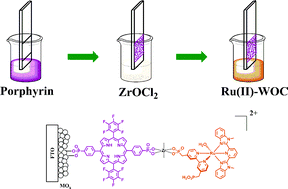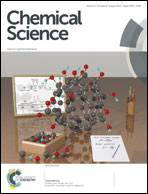Synthesis and photophysical characterization of porphyrin and porphyrin–Ru(ii) polypyridyl chromophore–catalyst assemblies on mesoporous metal oxides†
Abstract
A layer-by-layer procedure has been used to prepare chromophore–catalyst assemblies consisting of phosphonate-derivatized porphyrin chromophores and a phosphonate-derivatized Ru(II) water oxidation catalyst on the surfaces of SnO2 and TiO2 mesoporous, nanoparticle films. In the procedure, initial surface binding of the phosphonate-derivatized porphyrin is followed in sequence by reaction with ZrOCl2 and then with the phosphonate-derivatized water oxidation catalyst [RuII(2,6-bis-(1-methylbenzimidazole-2-yl)pyridine)(2,2′-bipyridine-4,4′-hydroxymethylphosphonate)(H2O)]2+, [RuII(Mebimpy)(4,4′-(PO(OH)2–CH2)2-bpy)(OH2)]2+. Fluorescence from both the free base and Zn(II) porphyrin derivatives on SnO2 is quenched; substantial emission quenching of the Zn(II) porphyrin occurs on TiO2. Transient absorption difference spectra provide direct evidence for appearance of the porphyrin radical cation on SnO2via excited-state electron injection. For the chromophore–catalyst assembly on SnO2, transient absorption difference spectra demonstrate rapid intra-assembly electron transfer oxidation of the catalyst following excitation and injection by the porphyrin chromophore.


 Please wait while we load your content...
Please wait while we load your content...